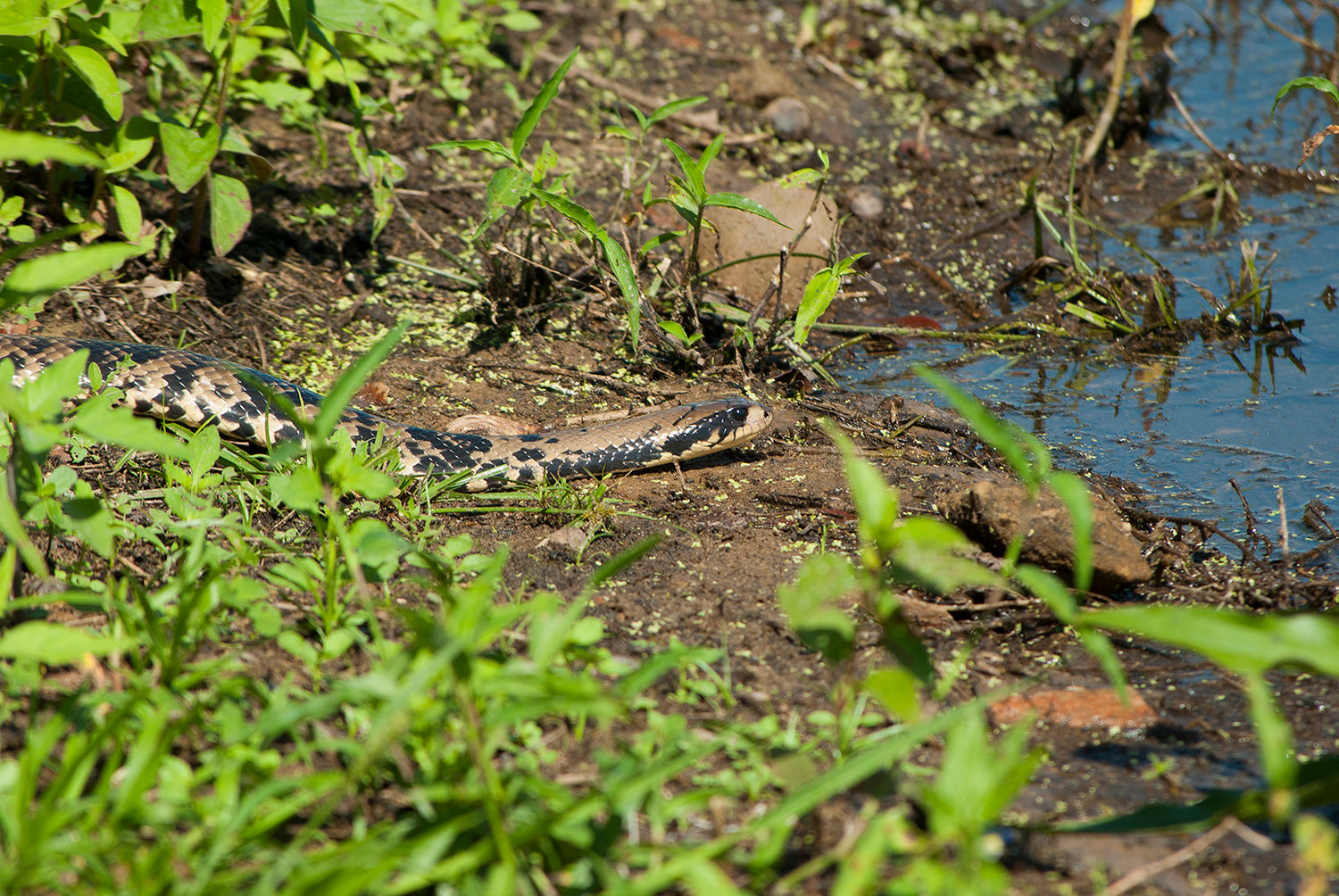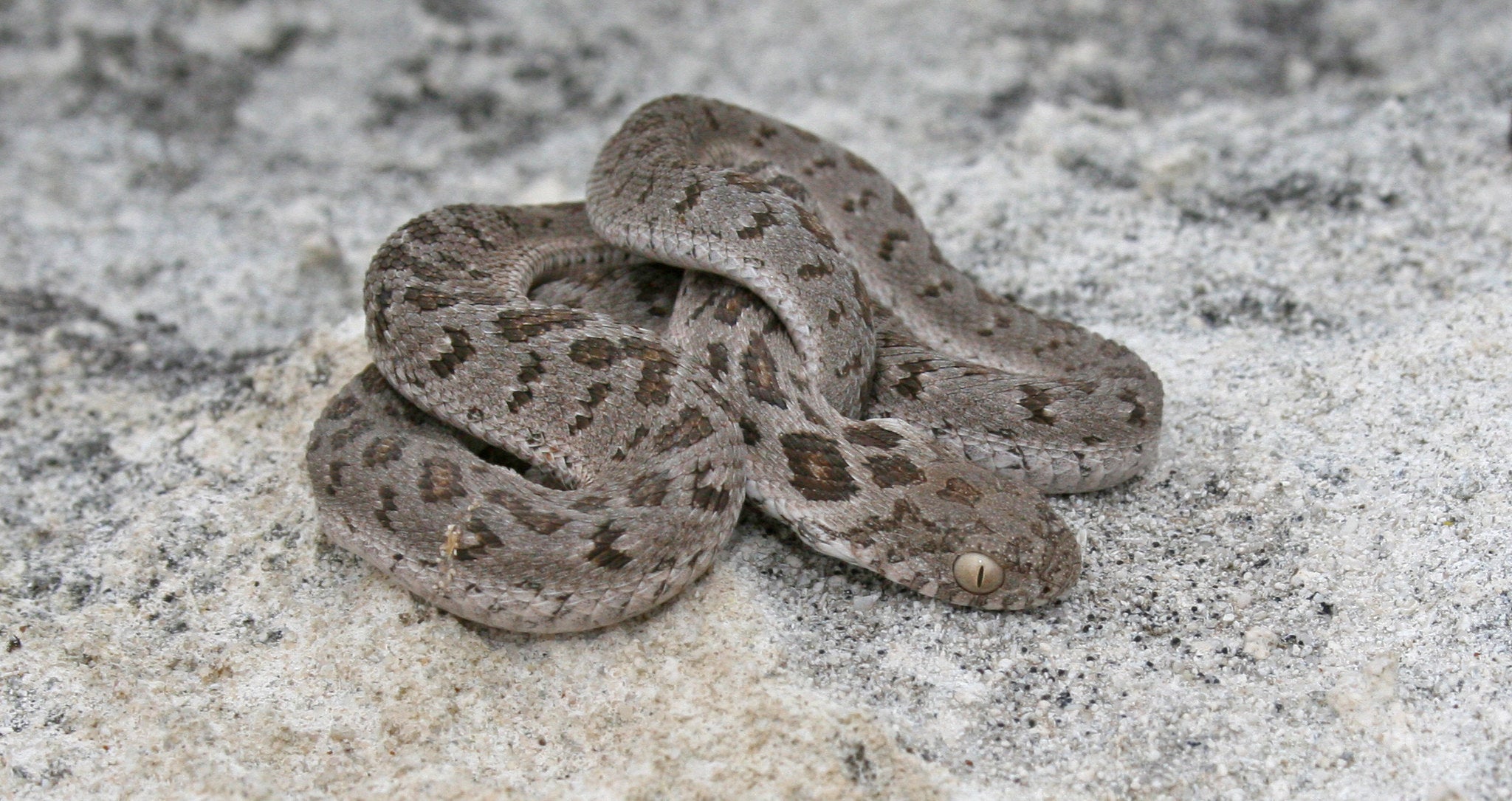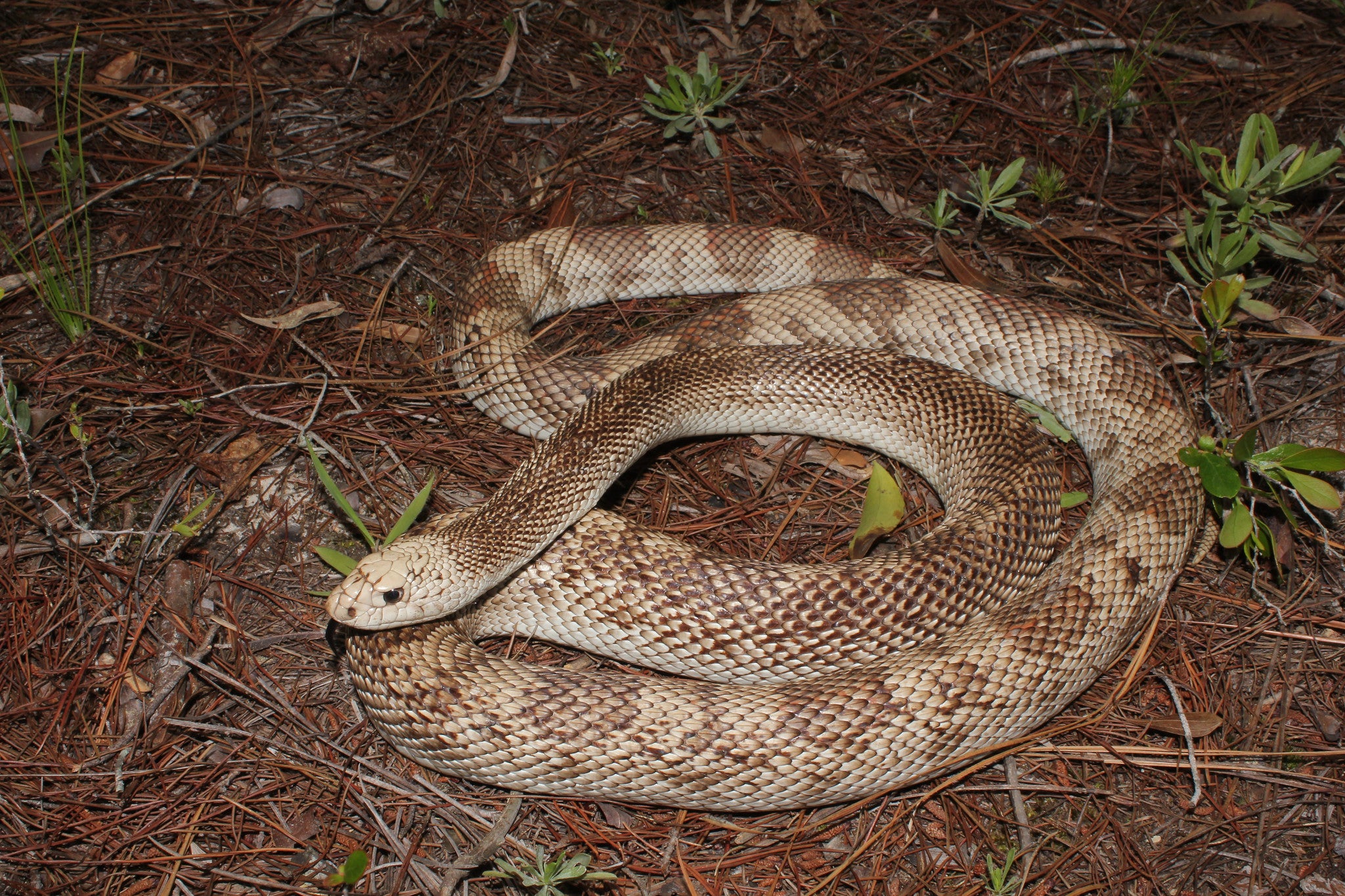False water cobras (Hydrodynastes gigas) are large, semi-aquatic, diurnal snakes found throughout South America east of the Andes mountain range. They prefer scrub forest and open wetland habitats, and have a highly active lifestyle.
False water cobras can be identified by their relatively small, rounded head, dark eyes, glossy scales, and the “hood” on their neck that is created when they are agitated. Males grow to 6-7’ long on average, but females generally grow to 7-8’. In terms of color, false water cobras generally have a brown to yellow base color with a mottled black pattern and bold black bands behind each eye.
False water cobras are rear-fanged venomous. Although their venom is not considered dangerous to humans, it can cause some discomfort when enough of it is injected, so bites should still be avoided as much as possible. This also makes this species somewhat more demanding/challenging to care for.
Furthermore, false water cobras require more maintenance than other snakes, so only consider this pet if you have the time and resources to keep up with their needs. With appropriate care, however, they can live 15-20 years, possibly longer.
How much space do false water cobras need?
All snakes need an enclosure that allows them enough space to stretch out, thermoregulate, and move around as desired. For a large, active snake like the false water cobra, that requires an 8’L x 3’W x 3’H enclosure or larger — particularly for large females.
Young false water cobras grow quickly, and are capable of growing to 5-6’ long within their first year of life, so it’s best to start with a large enclosure rather than try to buy multiple smaller enclosures that your pet will outgrow almost immediately. If you are concerned about the enclosure being too large at first, use a divider to reduce the available space within the enclosure and then move the divider as the snake grows.
Cohabitation (keeping multiple false water cobras in one enclosure) is not recommended, as this is not a social species, and keeping them together is likely to cause stress. Furthermore, considering that this species is known to eat snakes, cannibalism is a very real danger.
Do false water cobras need UVB?
They can survive without it, but it’s still best practice to provide UVB lighting for optimal health and wellbeing, particularly considering that false water cobras are a diurnal species. UVB gives snakes all of the vitamin D that their bodies need, stimulates better appetite and activity, and generally allows them to be healthier than they would be without.
False water cobras do best with low-strength UVB as part of their enclosure. The best UVB bulbs for false water cobras in a 3-4’ tall enclosure are:
- Zoo Med Reptisun T5 HO 5.0, 46"
- Arcadia Forest 6%, 46"
The UVB bulb should be roughly half the length of the enclosure and housed in a reflective fixture such as the Arcadia ProT5 or Vivarium Electronics for best output. It must also be placed close to the heat lamps, about 9-11” above the basking platform if over mesh, and 12-14” above the basking platform if not. UVB is blocked by glass and plastic, so make sure that the fixture your UVB bulb is in does not have a clear plastic bulb cover.
Lights should be on for 12 hours/day, or synced with your local sunrise and sunset times for seasonal variation.
What basking temperatures do false water cobras need?
Like other reptiles, false water cobras are ectotherms, which means that they need a temperature gradient in their enclosure to help them regulate their metabolism and stay healthy.
False water cobras should have a basking temperature around 88°F. On the other side of the enclosure, the temperature should be around 77°F. These temperatures should be measured with digital probe thermometers, one on the basking surface and one on the cool side. Heating should be turned off at night, allowing temperatures to fall down to 72°F.
Provide heat for your snake by imitating the sun with a cluster of four halogen flood heat lamps placed close together one side of the enclosure, positioned over a flat basking surface. Do not use ceramic heat emitters (CHEs), red bulbs, or blue bulbs, as these are not as effective.
If your basking temperature is too hot, use a rheostat or proportional thermostat to reduce the lamps’ heat output. If your basking temperature is not hot enough, you will need higher-wattage bulbs.
What humidity levels do false water cobras need?
False water cobras are semi-aquatic, so they need access to a relatively large body of water and moderate levels of ambient humidity. Aim for an average humidity between 30-60%, fluctuating higher at night and lower during the day.
Misting your snake’s enclosure with a pressure sprayer daily will help create the right humidity levels. Humidity levels should be measured by a digital probe hygrometer placed in the middle of the enclosure. There should also be a humid hide for your snake, lined with moistened sphagnum moss. Always having a humid retreat is essential for healthy shedding!
Your false water cobra also needs access to a basin of water large enough to comfortably accommodate the snake’s entire body. Plastic tubs used for dishwashing are large and have a drainage port at the bottom, which makes them an easy-clean option for this purpose. Change the water whenever it becomes soiled, and scrub the bowl with a reptile-safe disinfectant before replacing.
Providing occasional swimming opportunities in a bathtub or kiddie pool of room-temperature water is likely to make a good enrichment activity as well!
What substrate is good for false water cobras?
False water cobras produce a lot of waste proportionate to their high metabolism, so an appropriate substrate for this species must not only be humidity-friendly and able to cushion the snake’s body, but it also must be absorbent and easy to replace. We recommend the following substrates for false water cobras:
Layering clean, chemical-free leaf litter on top of the substrate can also help with humidity, and also provides a great form of enrichment!
Substrate should be 4-6” deep and completely replaced every month. The enclosure should be thoroughly disinfected during this time as well. Remove poop and urates daily, and replace all contaminated substrate.
What décor can you use in a false water cobra enclosure?
It’s terribly boring for a snake to be stuck in an enclosure with nothing in it except substrate, hides, and a water bowl. It doesn’t matter how big the enclosure is if you don’t put things in it for your pet to use and interact with.
Aside from hiding places, you will also need at least a couple of low, sturdy branches for your snake to climb on, as well as some durable artificial foliage to provide cover. Hollow logs, cork flats, leaf litter, and other items to explore can also be useful!
What do false water cobras eat?
Like other snakes, false water cobras are carnivores, which means that they need to eat whole animal prey in order to get the nutrition that they need. Here is a basic feeding schedule based on snake age:
- Juveniles should be fed every 4-5 days
- Adults should be fed once every 5-6 days
While obesity is definitely something to be avoided with any pet, keep in mind that false water cobras have unusually high metabolisms, and need to eat more frequently than most other snakes.
Prey items should be relatively small, preferably at least slightly smaller than the snake at its widest point. Although live prey can be used, it’s safest and most humane to use frozen instead. Prey should be completely thawed in a plastic bag in warm water before offering with a pair of soft-tipped tweezers.
Remember, the key to great nutrition is variety! Aside from offering mice and rats, quail, chicks, green anoles, frogs, and smaller snakes can also be used to create nutritional variety in your false water cobra’s diet.
Supplements
Snakes can survive without vitamin or mineral supplements, but occasionally using them can help prevent nutritional deficiencies and optimize your snake’s health. We recommend Repashy Calcium Plus LoD.
Do false water cobras like to be handled?
Few reptiles actually “like” to be held, but false water cobras tend to tame down well as they age, becoming inquisitive, interactive pets. To handle your false water cobra, be gentle, and pick up the snake from below rather than from above. Support as much of its body as possible, and NEVER pick up a snake by its tail!
Sometimes snakes don’t want to be bothered. Your false water cobra may indicate that it wants to be left alone for the day by spreading its hood or thumping/whipping its tail. Respecting their preferences will help you build trust with your pet.
*This care sheet contains only very basic information. Although it’s a good introduction, please do further research with high-quality sources to obtain additional information on caring for this species.
"Hydrodynastes gigas eu acho" by Algis Fechtner is licensed under CC BY-NC-SA 2.0.




Leave a comment
This site is protected by hCaptcha and the hCaptcha Privacy Policy and Terms of Service apply.